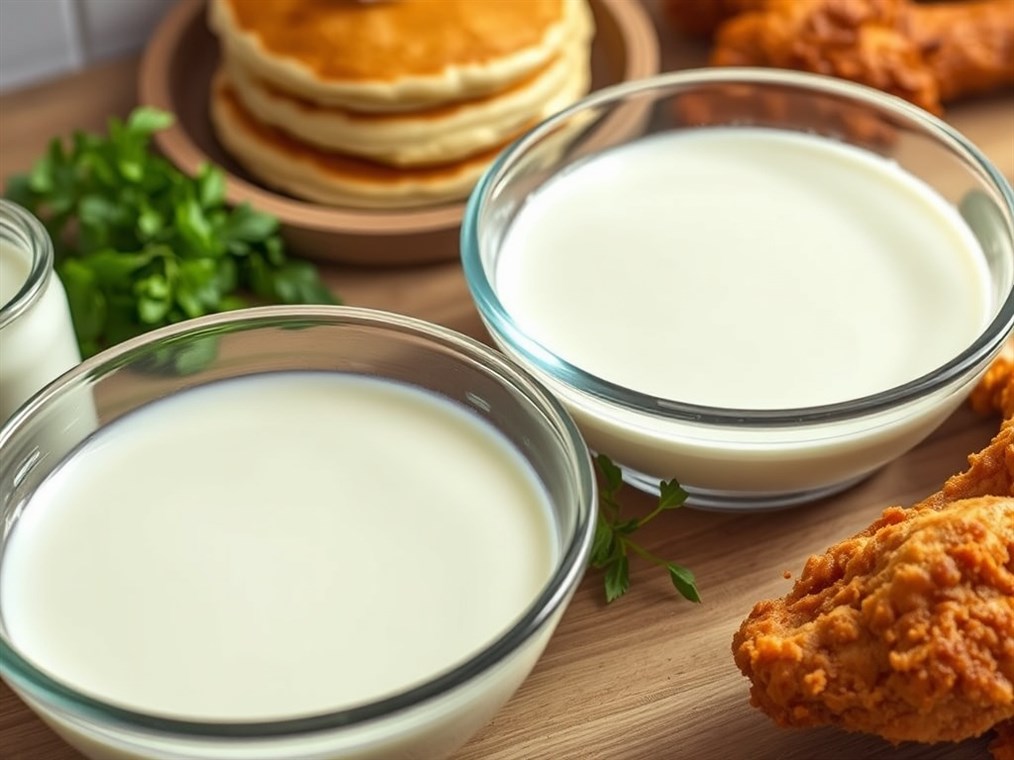Buttermilk vs. Low-Fat Buttermilk: What’s the Real Deal?
Buttermilk. Just the name conjures up images of fluffy pancakes and crispy fried chicken, doesn’t it? It’s that tangy, creamy ingredient that can really take a dish from good to amazing. But then you’re at the grocery store, staring at the dairy case, and a question pops into your head: Regular buttermilk or low-fat buttermilk? What’s the actual difference? Well, pull up a chair, because there is a difference, and knowing it can seriously up your cooking game.
So, what is buttermilk anyway? Back in the day, it was literally the liquid leftover after churning butter – a happy accident! This stuff was naturally low in fat and had a bit of a sour kick thanks to fermentation. Nowadays, most of what you find is cultured buttermilk. Think of it as the modern makeover: they add specific bacteria to low-fat or nonfat milk, let it do its thing, and voila! You get that classic buttermilk tang from the lactic acid.
Now, let’s talk numbers. The main difference boils down to, well, fat. Here’s a quick rundown based on a 1-cup serving:
- Buttermilk (Regular/Whole): Around 100 calories and about 2.2 grams of fat (1.3 grams saturated).
- Low-Fat Buttermilk: Somewhere in the 98-120 calorie range, with roughly 1.5-2.6 grams of fat (about 1 gram saturated).
Honestly, the calorie and fat differences aren’t huge, but if you’re keeping a close eye on your fat intake, it’s worth noting.
To get super specific, here’s a breakdown per 100 grams, comparing the two:
- Water: 87.9g (Whole), 89.8g (Low-Fat)
- Protein: 3.21g (Whole), 3.46g (Low-Fat)
- Total Fat: 3.31g (Whole), 1.08g (Low-Fat)
- Carbohydrates: 4.88g (Whole), 4.81g (Low-Fat)
- Calcium: 115mg (Whole), 120mg (Low-Fat)
- Iron: 0.03mg (Whole), 0.01mg (Low-Fat)
- Magnesium: 10mg (Whole), 11mg (Low-Fat)
- Phosphorus: 85mg (Whole), 92mg (Low-Fat)
- Potassium: 135mg (Whole), 158mg (Low-Fat)
- Sodium: 105mg (Whole), 92mg (Low-Fat)
Okay, enough with the stats! Let’s get to the good stuff: taste and texture. Both have that signature tangy flavor we all love, thanks to the lactic acid. But the fat does make a difference in how it feels in your mouth. Regular buttermilk is a bit richer and creamier, while the low-fat version is lighter and brighter.
Now, how do you use this magical stuff? The great news is you can usually swap ’em out in recipes without a hitch. Both are rockstars in:
- Baking: This is where buttermilk shines. It’s the secret to seriously tender and fluffy pancakes, biscuits, cakes – you name it. That acidity reacts with baking soda to create all those lovely air bubbles.
- Marinades: Want chicken that practically melts in your mouth? Buttermilk is your friend. It tenderizes meat like a charm, especially chicken and pork. It’s like a spa day for your protein!
- Dressings and Dips: Ranch dressing just isn’t the same without that buttermilk zing, am I right?
- Drinks: In some cultures, like in India, buttermilk is enjoyed as a refreshing drink all on its own. Give it a try!
One thing to watch out for: sodium. Buttermilk can be surprisingly salty, with some brands packing a hefty dose per cup. And get this – sometimes the lower-fat versions have more sodium! So, if you’re watching your salt intake, read those labels.
Don’t have buttermilk on hand? No sweat! You can whip up a quick substitute by adding a tablespoon of lemon juice or white vinegar to a cup of milk. Let it sit for a few minutes until it thickens a bit. It won’t have that same cultured flavor, but it’ll do the trick in most baking situations.
So, bottom line? Whether you go for regular or low-fat buttermilk, you’re getting a fantastic ingredient that can seriously elevate your cooking. If you’re counting grams of fat, go low-fat. But if you want that extra bit of richness, stick with the regular stuff. Either way, you’re in for a treat!

